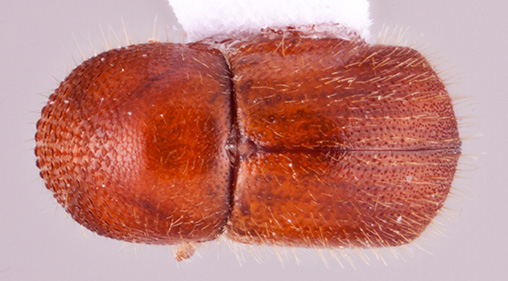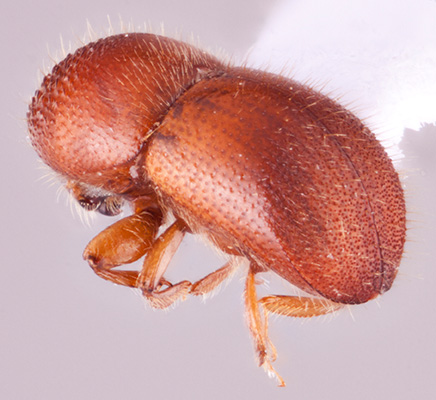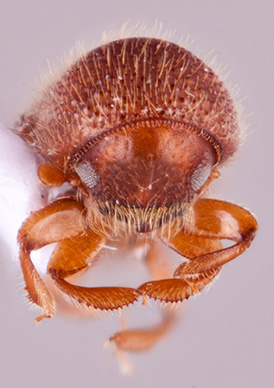Xylosandrus crassiusculus
|
Xylosandrus crassiusculus lateral; R.K. Osborn |
|
Xylosandrus crassiusculus dorsal; R.K. Osborn |
|
Xylosandrus crassiusculus declivity; R.K. Osborn |
|
Xylosandrus crassiusculus frontal; R.K. Osborn |
Taxonomic history
Phloeotrogus crassiusculus Motschulsky, 1866: 403.
Xylosandrus crassiusculus (Motschulsky): Wood, 1977a: 68.
Synonyms
Xyleborus semiopacus Eichhoff, 1878b: 334. Wood, 1969c: 119.
Xyleborus semigranosus Blandford, 1896b: 211. Schedl, 1959a: 496.
Dryocoetes bengalensis Stebbing, 1908b: 12. Beeson, 1915b: 297.
Xyleborus mascarenus Hagedorn, 1908: 379. Eggers, 1923a: 130.
Xyleborus ebriosus Niijima, 1909: 154. Choo, 1983: 98.
Xyleborus okoumeensis Schedl, 1935f: 271. Schedl, 1959a: 496.
Diagnosis
2.3−2.9 mm long (mean = 2.58 mm; n = 5); 2.17−2.42 times as long as wide. This species is distinguished by the moderate to large size; elytralelytral:
'pertaining to the elytra
discdisc:
the flat central upper surface of any body part (e.g. pronotum and elytra) gradually curving toward declivitydeclivity:
gradually curving toward declivitydeclivity:
downward slope of either the pronotum or elytra
 , appearing rounded; posterolateralposterolateral:
, appearing rounded; posterolateralposterolateral:
'relating to end of the side part/portion
 margins of elytraelytron:
margins of elytraelytron:
'
the two sclerotized forewings of beetles that protect and cover the flight wings
carinate to interstriaeinterstria:
'longitudinal spaces along the elytra between the striae, which is not as<br />
impressed and bear smaller punctures.
 7; declivitaldeclivital:
7; declivitaldeclivital:
pertaining to the elytral declivity
face with 6 striae; interstriaeinterstria:
'longitudinal spaces along the elytra between the striae, which is not as<br />
impressed and bear smaller punctures.
 and striaestria:
and striaestria:
punctures in rows, which may or may not be impressed to make grooves granulategranulate:
granulategranulate:
'pertaining to a coarse, grainy surface texture'
 , confusedconfused:
, confusedconfused:
of markings, having indefinite outlines or running together as lines or spots without definite pattern; usually referring to punctures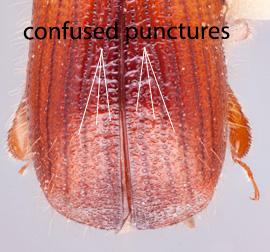 , appearing dull, with erecterect:
, appearing dull, with erecterect:
'pertaining to setae that have their apices directed away from the body and appear straight
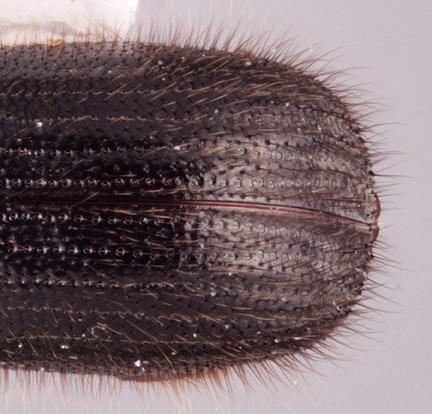 hair-like setaeseta:
hair-like setaeseta:
small hair-like or scale-like structure
longer than the width of two interstriae; pronotumpronotum:
'the dorsal surface of the thorax
wider than long, pronotumpronotum:
'the dorsal surface of the thorax
from dorsaldorsal:
'of or relating to the upper surface; opposite of ventral
 view rounded (type 1) and laterallateral:
view rounded (type 1) and laterallateral:
'pertaining to the side
 view basic (type 0), summitsummit:
view basic (type 0), summitsummit:
highest point, used for pronotum and elytra, denotes the peak between pronotal frontal slope and disc, and between elytral disc and declivity at midpoint, basalbase:
at midpoint, basalbase:
point or edge closest to the body; opposite of apex half smooth, shiningshining:
half smooth, shiningshining:
appearing glossy or bright in luster; referring to a surface that is polished and reflects light well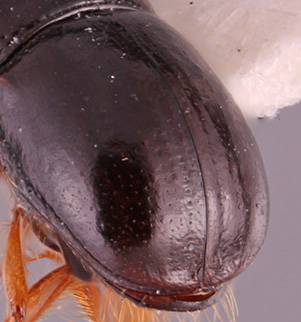 , sparsely minutely punctatepunctate:
, sparsely minutely punctatepunctate:
'set with fine impressed points, appearing as pin pricks
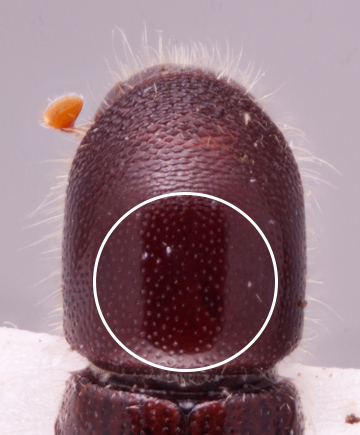 ; and dense mycangial tuftmycangial tuft:
; and dense mycangial tuftmycangial tuft:
'tuft of setae that denotes the mycangia exterior opening
 on the pronotalpronotal:
on the pronotalpronotal:
'pertaining to the pronotum
basebase:
point or edge closest to the body; opposite of apex .
.
The species can be distinguished from X. declivigranulatus by the following combination of characters (X. declivigranulatus given first): 2.1 mm long vs. 2.3–2.9 mm long (Smith et al. 2020); 2.0× as long as wide vs. 2.17–2.42× as long as wide (Smith et al. 2020); pronotumpronotum:
'the dorsal surface of the thorax
as long as wide vs. 0.73–0.93 times as long as wide; declivitydeclivity:
downward slope of either the pronotum or elytra
 densely granulategranulate:
densely granulategranulate:
'pertaining to a coarse, grainy surface texture'
 , granulesgranule:
, granulesgranule:
'a small rounded protuberance, like grains of sand
 spaced by less than one diameter of a granulegranule:
spaced by less than one diameter of a granulegranule:
'a small rounded protuberance, like grains of sand
 , surface of declivitaldeclivital:
, surface of declivitaldeclivital:
pertaining to the elytral declivity
face difficult to discern between granulesgranule:
'a small rounded protuberance, like grains of sand
 , granulesgranule:
, granulesgranule:
'a small rounded protuberance, like grains of sand
 comparatively larger vs. declivitydeclivity:
comparatively larger vs. declivitydeclivity:
downward slope of either the pronotum or elytra
 sparsely to moderately granulategranulate:
sparsely to moderately granulategranulate:
'pertaining to a coarse, grainy surface texture'
 , granulesgranule:
, granulesgranule:
'a small rounded protuberance, like grains of sand
 spaced 2–5 diameters of a granulegranule:
spaced 2–5 diameters of a granulegranule:
'a small rounded protuberance, like grains of sand
 , surface of declivitaldeclivital:
, surface of declivitaldeclivital:
pertaining to the elytral declivity
face apparent, granulesgranule:
'a small rounded protuberance, like grains of sand
 comparative smaller, often minute.
comparative smaller, often minute.
May be confused with
Distribution
Circumtropical. Within the study region recorded from Bhutan, Cambodia, China (Anhui, Fujian, Guangdong, Guangxi, Guizhou, Hainan, Hebei, Hong Kong, Hubei, Hunan, Jiangsu, Jiangxi, Shaanxi, Shandong, Shanghai, Sichuan, Xizang, Yunnan, Zhejiang), India (Andaman Is, Arunchal Pradesh, Assam, Himachal Pradesh, Karnataka, Meghalaya, Sikkim, Tamil Nadu, Uttarakhand, West Bengal), Japan, Korea, Laos, Myanmar, Nepal, Taiwan, Thailand, Vietnam. Imported to and established in Europe, North, Central, and South America, Africa (Kirkendall and Ødegaard 2007, Pennacchio et al. 2003Pennacchio et al. 2003:
Pennacchio F, Roversi PF, Francardi V, Gatti E. 2003. Xylosandrus crassiusculus (Motschulsky) a bark beetle new to Europe (Coleoptera Scolytidae). Redia 86: 77-80., Flechtmann and Atkinson 2016Flechtmann and Atkinson 2016:
Flechtmann CAH, Atkinson TH. 2016. First records of Xylosandrus crassiusculus (Motschulsky) (Coleoptera: Curculionidae: Scolytinae) from South America, with notes on its distribution and spread in the New World. The Coleopterists Bulletin 70: 79-83. https://doi.org/10.1649/072.070.0109, Landi et al. 2017Landi et al. 2017:
Landi L, Goacute;mez D, Braccini CL, Pereyra VA, Smith SM, Marvaldi AE. 2017. Morphological and molecular identification of the invasive Xylosandrus crassiusculus (Motschulsky) (Coleoptera: Curculionidae: Scolytinae) and its South American range extending into Argentina and Uruguay. Journal of Economic Entomology 110: 344-349. https://doi.org/10.1093/aesa/sax032, Gallego et al. 2017Gallego et al. 2017:
Gallego D, Lencina JL, Mas H, Ceveroacute; J, Faccoli M. 2017. First record of the granulate ambrosia beetle, Xylosandrus crassiusculus (Coleoptera: Curculionidae: Scolytinae), in the Iberian Peninsula. Zootaxa 2743: 431-434. http://dx.doi.org/10.11646/zootaxa.4273.3.7, Gomez et al. 2018aGomez et al. 2018a:
Gomez DF, Rabaglia RJ, Fairbanks KEO, Hulcr J. 2018a. North American Xyleborini north of Mexico: a review and key to genera and species (Coleoptera, Curculionidae, Scolytinae). ZooKeys 768: 19-68. https://doi.org/10.3897/zookeys.768.24697, Nel et al. 2020).
Host plants
strongly polyphagous (Dole and Cognato 2010Dole and Cognato 2010:
Dole SA, Cognato AI, 2010. Revision of Xylosandrus Reitter (Curculionidae: Scolytinae). Proceedings of the California of Science 61: 451-545.)
Remarks
The basic biology has been described by Browne (1961a), Schedl (1963a) (both as Xyleborus semiopacus), and Ranger et al. (2016), amongst others. Flight activity and the attraction of flying adults to ethanol has been studied in the southern USA by Reding et al. (2011, 2013), attack densities and adult emergence on various hosts by Mayfield et al. (2013), and attraction to volatiles from the symbiotic ambrosia fungus by Hulcr et al. (2011). This is a species of economic importance because, like Xylosandrus compactus, it can attack and breed in healthy shoots and twigs. This can result in the introduction of pathogenic fungi (Sreedharan et al. 1991Sreedharan et al. 1991:
Sreedharan K, Balakrishnan M, Sanuel S, Bhat P. 1991. A note on the association of wood-boring beetles and a fungus with the death of silver oak trees on coffee plantations. Journal of Coffee Research 21: 145-148., Davis and Dute 1997Davis and Dute 1997:
Davis MA, Dute RR. 1997. Fungal associates of the Asian ambrosia beetle, Xylosandrus crassiusculus . Southern Nursery Association Research Conference 42: 106-112.). It seems to be an infrequent pest in the Oriental and Afrotropical regions, although attacks on transplants have been recorded (e.g. Browne 1968aBrowne 1968a:
Browne FG. 1968a. Pests and diseases of forest plantation trees: An annotated list of the principal species occurring in the British Commonwealth. Clarendon Press, Oxford, xi + 1330 pp.). It is of greater importance in the USA, where its ecology and management in plant nurseries is discussed by Ranger et al. (2016).
DNA data
Sequences available for COI and CAD.
COI: GU808708; GU808709; GU808710; GU808711; MN620070; MN620071; MN620072; MN620073; MN620074;MN620075;MN620076;MN620077;MN620078
CAD: GU808630; GU808631; GU808632; GU808633; MN620331; MN620332; MN620333; MN620334; MN620335; MN620336; MN620337; MN620338; MN620339; MN620340; OP607265; OP607266; OP607267; OP607268; OP607269; OP607270; OP607271; OP6072672


